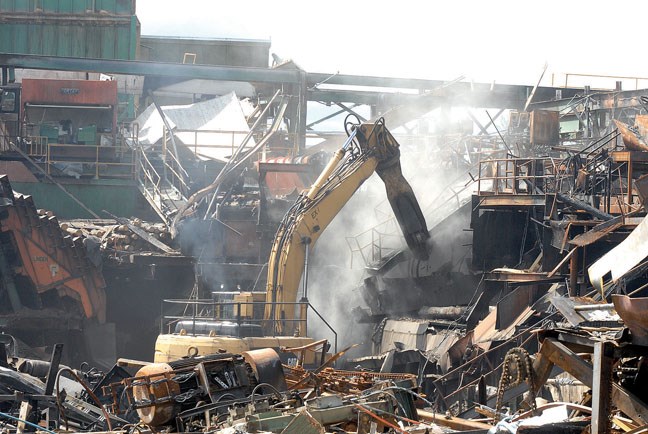No charges will be laid against the owners of Babine Forest Products for the fire and explosion that destroyed the Burns Lake mill in January 2012, killing two and injuring dozens.
Provincial Crown counsel announced on Friday that they were dropping the case into the four administrative charges WorkSafeBC had recommended and the criminal charges that they were empowered to extract from the evidence. Further, the Crown harshly condemned WorkSafeBC's investigation into the deadly fire.
It was also disclosed that the cause of the blast could not be determined. Experts differed on the mechanics of the incident so much that it is impossible to know what actually caused the ignition and the explosion to occur. It seems to have started in the basement of the wood processing factory, and wood dust seems to be a player in the destruction, but a definitive cause was not forthcoming from the available evidence.
In a lengthy statement issued by the Criminal Justice Branch, two main points were stressed.
First, the investigation style used by WorkSafeBC rendered significant amounts of evidence that would have been inadmissible to court. Second, the owners of the mill could show a pattern of due diligence pertaining to workplace dust safety, making it unlikely that Crown could win a conviction.
"The standard of proof for a regulatory offence under provincial legislation is the same as the standard of proof for an offence under the Criminal Code. If charges are approved, the prosecution bears the burden of proving the alleged offence beyond a reasonable doubt," said a written statement by the Criminal Justice Branch.
The standard defence of "due diligence" was a likely course of action, should the owners of Babine be taken to court, said the ministry. They were confident they could show Babine's management knew very well that accumulated wood dust caused a fire hazard and even a threat for small explosions.
"However, Babine would likely be able to establish that it did not foresee and could not reasonably have foreseen that sawdust could cause a catastrophic explosion of the nature that occurred on January 20, 2012."
Furthermore, said the Crown statement, WorkSafeBC itself did inspections of Babine and flagged it for certain dust mitigation measures, but made no mention of a major danger.
There was also evidence gathered by WorkSafeBC suggesting the dust had been recently cleaned at Babine, and that they had been milling mostly green wood, not drier dead pine wood presumed to be more of a threat to explode, during that week and on the day of explosion. They were also running at a slower pace than usual on that day.
"While evidence varies as to the degree of sawdust buildup in the mill, most workers reported that dust conditions in the sawmill in the week leading up to and on the day of the fire, including airborne sawdust conditions, were as good as or better than they had been since the mill started processing beetle-killed wood, for example, as 'cleaner than usual,' 'fairly clean,' 'pretty clean, and 'down to the minimal it's going to get.' One worker noted that 'it was normal to always (have) a certain amount of sawdust in the work environment," the Crown's report said.
"A WorkSafeBC officer who regularly inspected Babine and other sawmills in the area reported that Babine's dust conditions were about the same as those in the other regional mills," the document added.
WorkSafeBC had recommended that charges be laid for:
- Failing to prevent hazardous accumulation of material
- Failing to safely remove combustible dust
- Failing to ensure the health and safety of workers
- Failing to remedy hazardous workplace conditions
Crown counsel, however, criticized WorksafeBC for its investigation of the blast.
"WSBC was not using any standard major case management methodology. This approach left important issues partially or wholly unexamined," said Crown's statement. "Within the specific context of the Babine investigation, this approach has significant implications for the legal admissibility of evidence gathered by WSBC."
Crown said the WSBC investigators handled the situation "as a safety-compliance inspection rather than as an investigation into possible criminal or regulatory enforcement. Thus, for example, WSBC did not obtain a search warrant authorizing search and seizure at the Babine site... Similarly, when officers interviewed the president of Babine, they did not provide him with any Charter of Rights warning or caution."
WorkSafeBC rejected the criticism of their investigative techniques.
In a statement issued by Jeff Dolan, director of investigations for WorksafeBC, he said the agency had been involved in plenty of major cases alongside Crown.
"Prior to the Babine investigation, Crown counsel approved charges in 31 cases between 1996 and 2010, 24 of which resulted in a conviction," Dolan said. "In [those 31 cases] investigators gathered and submitted evidence to Crown counsel using the WorkSafeBC investigation methodologies and authorities granted by the Workers Compensation Act."
As an example he pointed to the convictions obtained in the multi-fatality incident involving Langley mushroom farm workers. Their investigation methods were successful in that complex court action less than one year before the Babine incident.
The Babine investigation was conducted by a team of 30 people over the course of 10 months using additional experts and laboratories in B.C., Eastern Canada and the U.S., Dolan said.



